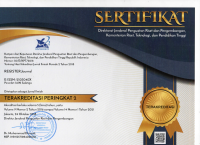AN ANALYSIS ON SUBTITLING STRATEGIES OF ROMEO AND JULIET MOVIE
Abstract
The focus of this research is to identify the subtitling strategies applied in the subtitling of Romeo and Juliet movie. This research belongs to descriptive qualitative research along with purposive sampling techniques. The objects of the research are English sentences spoken by the actors and actress in Romeo and Juliet movie as a source text (ST) and its Indonesian subtitling as a target text (TT).
The research findings show that the subtitling strategies applied in Romeo and Juliet movie are expansion, paraphrase, transfer, imitation, condensation, decimation, deletion, taming, and resignation. Among those strategies; condensation is the most dominant one due to the limited space and subtitling time appearance because in the subtitling process, there should be a thrifty translation whereas, the accuracy of Romeo and Juliet subtitling depends on the context covers the text, both situation context and cultural context. There are three components covers the situation context, namely field, mode/channel, and tenor/relation.
The key words: subtitling strategy, subtitling accuracy, thrifty translation
Keywords
Full Text:
PDFReferences
Basnnett, S. & Lefevere, A.(1995). Translation, History and Culture, USA: Cassell.
Bell, R.T. (1991). Translation and Translating: Theory and Practice. London: Longman.
Bordwell, F. & Thompson, K. (1990). Film Art. USA: Mc Graw-Hill, Inc.
Catford, J.C. (1965). A Linguistic Theory of TranslationI. London: Oxford University Press.
Cintas, W. (2005). “The Viewer as the Focus of Subtitling”. Translation Journal. URL: http://accurapid.com/journal/32film.htm. updated on:12/26/2010.
Gambier, Y. (1993). “Audio Visual Communication: Typological Detour”. Teaching Translation and Interpreting 2. Philadelphia: John Benjamin.
Haryanto, S. (2005). “Subtitling: Di antara Keterbatasan Bahasa-Budaya dan Media”. Collection of International Conference on Translation:Translation, Discourse and Culture. Program Pascasarjana: UNS.
Hoed, B.H. (1992). Linguistik, Semiotik, dan Kebudayaan Kita. Pidato Pengukuhan Guru Besar pada Fakultas Sastra Universitas Indonesia.
Houbert, F. (1998). “Translation as Communication Process” dalam Translation Journal and the Authors 1998 Volume 2, No. 3 July 1998; Available from URL:http://accurapid.com/journal/htm. updated on: 12/26/2010
Larsen. (1993). “The Subtitling of Film: Reaching Another Community”. Translation Journal, URL: http://accurapid.com/journal/32film.htm. updated on:12/26/2010.
Larson, M.L. (1998). Meaning Based Translation: A Gude to Cross-Language Equivalence. (Second Edition). USA: University Press of America, Inc.
Moeliono, A. (1995). Implikasi Penerjemahan dalam Pengembangan Bahasa Indonesia. Proyek PS2PT. DIKTI.
Nida, Eugene.(1975). Componential Analysis of Meaning. The Hague – Paris: Mouton.
Nida, Eugene & Taber, C. (1974). The Theory and Practice of Translation. Leiden: E.J. Brill.
Santoso, R. (2003). Semiotika Sosial Pandangan Terhadap Bahasa. Surabaya: Pustaka Eureka & JP Press.
White, B. (2008). “Subtitling: The Museum of Broadcast Communication”. Translation Journal, URL: http://accurapid.com/journal/32film.htm. updated on:4/1/2011.
Widodo, E. & Mukhtar. (2000). Kontribusi ke Arah Penelitian Descriptif. Yogyakarta: Avyrous.
DOI: https://doi.org/10.18326/rgt.v8i1.57-80
Refbacks
Copyright (c) 2015
License URL: https://creativecommons.org/licenses/by-sa/4.0/










